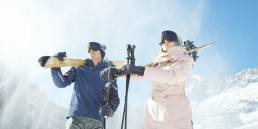FALLING FOR CANADA’S MOST EXOTIC WINTER PROVINCE
There was the snow, luxurious and bountiful, piled high along the Québec country byway. There was the farmhouse, a fire crackling in the hearth and eiderdown comforters resting on the beds. There was the food, seasoned liberally, prepared carefully, with a brash gustatory accent that seemed altogether alien.
 There was the language, expressed with a zip and a zest that bore no resemblance to the plodding one syllable- at-a-time French I butchered in junior high in the Boston suburbs. Everything about this place was exotic or, to employ the local argot, exotique. Rural Québec and its ski life was, for me, love—love at first sight, love at first bite, love at first tracks.
There was the language, expressed with a zip and a zest that bore no resemblance to the plodding one syllable- at-a-time French I butchered in junior high in the Boston suburbs. Everything about this place was exotic or, to employ the local argot, exotique. Rural Québec and its ski life was, for me, love—love at first sight, love at first bite, love at first tracks.
If—as L.P. Hartley put it in the unforgettable opening of the beloved 1953 novel, The Go-Between—the past is a foreign country, my most vivid memory of my skiing past occurred in a foreign country, Canada, and in its most colorful winter province, Québec.
Years later—a half-century later—I would apply for Canadian citizenship, and would explain this inexplicable impulse to my American friends as paying homage to my mother’s native land. That was a fact. But this is the truth: I did it at least in part because of the croissants at the Cozi café in Saint-Sauveur-des-Monts, the romance of walking against a curtain of falling snowflakes along the village’s Rue Principale—and the rush I still feel, a dozen visits later, whooshing down a Mont Habitant trail called Le Petit Vin.
 I’ve been to ski towns that are just as historic, and to ski areas far bigger, but for me, no ski region has the same lure of the Laurentians—the small resorts, known as the Stations de la Vallée de Saint-Sauveur, illuminated brilliantly in the night chill along Autoroute 15; the mighty peaks of Mont Tremblant, forbidding against the cobalt-blue sky in sunshine, downright unwelcoming in the gray before the storm; and the poetry produced by the simple act of reciting the names of the towns out loud: Sainte-Adèle, Sainte-Marguerite-du-Lac-Masson, Saint-Adolphe-d’Howard, Lac-des-Seize-Îles, even Morin Heights, which isn’t a French name but where, in a restored barn not so long ago, I wolfed down maybe the best soupe à l’oignon gratinée ever produced in the New World.
I’ve been to ski towns that are just as historic, and to ski areas far bigger, but for me, no ski region has the same lure of the Laurentians—the small resorts, known as the Stations de la Vallée de Saint-Sauveur, illuminated brilliantly in the night chill along Autoroute 15; the mighty peaks of Mont Tremblant, forbidding against the cobalt-blue sky in sunshine, downright unwelcoming in the gray before the storm; and the poetry produced by the simple act of reciting the names of the towns out loud: Sainte-Adèle, Sainte-Marguerite-du-Lac-Masson, Saint-Adolphe-d’Howard, Lac-des-Seize-Îles, even Morin Heights, which isn’t a French name but where, in a restored barn not so long ago, I wolfed down maybe the best soupe à l’oignon gratinée ever produced in the New World.
True—or en réalité—I have history in Québec. I cherish a 1933 picture of my grandmother, no feminist icon but a downhill pioneer all the same, standing defiantly against the wind, in leather bindings on wooden skis atop Hill 69, now part of Mont Saint-Sauveur.
My two daughters are fourth-generation female skiers in the Laurentians. It is our family’s most devout conviction that the crêpes stuffed with béchamel cheese at la Crêperie à la Gourmandise Bretone are just heaven. My ski-heritage collection includes two plastic, rudimentary ponchos—maple leafs emblazed on the front, of course—that my wife and I were handed on a particularly rainy afternoon at Tremblant when we were young, which is to say before Intrawest converted a wreck of a ski area into a shimmery international entrepôt.
 But for us, it is the mix of the personal—and by this I mean the personal touch of the ski experience—and the historic that over the decades have made our Laurentian holidays unforgettable experiences.
But for us, it is the mix of the personal—and by this I mean the personal touch of the ski experience—and the historic that over the decades have made our Laurentian holidays unforgettable experiences.
We’re not the only family drawn to those hills and to other Québec ski venues: In the Eastern Townships, the famous Mont Orford is a magnet for skiers on both sides of the border.
Other memorable treks have been to Owl’s Head in Mansonville where I spent an unforgettable day overlooking frozen lake Memphrémagog (and devoured even more unforgettable duck-liver mousse, spread on a baguette, in a bistro adjacent to a classic boulangerie). Or up near Québec City, where we once rented a cottage with cousins, plied the slopes of Mont-Sainte-Anne and Le Massif and bought four paintings in a gallery in nearby Baie‑Saint‑Paul. Those pictures hang in our family and living rooms with their stark, cold village scenes providing warm memories in all seasons.
We’ve brought other things home with us: Swiss Gruyère cheese bought for a bargain at the incomparable S. Bourassa food warehouse; woolen hats—tuques, as they are known in the Québec hills; and a pink winter jacket for my wife that’s still the smartest piece of winter apparel in Pittsburgh, ever.
 All that plus beaucoup de sirop d’érable, or maple syrup, some of it from the Cabane à sucre Arthur Raymond, over in the tiny Laurentian village of Piedmont. It’s a hut nestled in the mountains that since 1955 has sent diners home with a (maple sugar) high that is legal if not exactly healthful. You can stuff yourself with all manner of food cooked in maple syrup, including omelettes, pork rinds, jambon fumé à l’érable prepared, naturally, on a fire of maple wood, and don’t forget the ragoût de boulettes, which sounds high-toned but translates into “meatball stew”—and persistent heartburn.
All that plus beaucoup de sirop d’érable, or maple syrup, some of it from the Cabane à sucre Arthur Raymond, over in the tiny Laurentian village of Piedmont. It’s a hut nestled in the mountains that since 1955 has sent diners home with a (maple sugar) high that is legal if not exactly healthful. You can stuff yourself with all manner of food cooked in maple syrup, including omelettes, pork rinds, jambon fumé à l’érable prepared, naturally, on a fire of maple wood, and don’t forget the ragoût de boulettes, which sounds high-toned but translates into “meatball stew”—and persistent heartburn.
A Québec trip is an outdoor holiday in an outdoor culture, created by the ultimate outdoor industry—forestry, which left vast stretches of cleared land on the upland hills. The railroad followed. The snow filled those sloping fields and the early ski crowd from Montreal filled those trains, and before long there were hotels, a ski club, and a ski culture that has no analogue anywhere in North America.
It used to be that Montrealers could step off the train at one station and ski to the next one. Though the trains are no longer, you can replicate the journey on rental Nordic skis and follow an old rail bed called the P’tit train du Nord. Former stations along the way have been transformed into beguiling bistros, congenial but not repellently cute, and filled with woodsmoke and café au lait.
The distinction between downhill and cross-country skiing emerged in the Laurentides, as the region is known in French, in the 1930s. With the appearance in that decade of primitive rope tows, mostly powered by truck engines, skiing became the principal economic activity. It remains so to this day.
And, even back then, skiing Québec style was to ski with a certain joie de vivre. “Today,’’ according to the 1937 Canadian Ski Year Book, “clothing, as well as being practical, has to be chic.’’
Ultimately—now, as in olden times—the skiing is the thing: night or day, in French or in English, Alpine or Nordic. Whichever way, it’s done to the soundtrack of a movie theme Gilles Vigneault wrote in 1965. The opening of the song has become a robust expression of Canadian identity: “Mon pays ce n’est pas un pays, c’est l’hiver.’’ That line, speaking of the homeland of the soul, is almost as poignant in English: “My country is not a country, it’s winter.’’ For many of us, on either side of the 49th parallel, those are words we live by.




